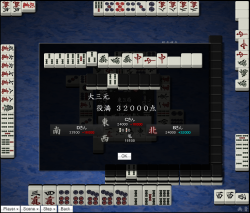Sekinin barai: Difference between revisions
| Line 32: | Line 32: | ||
=== Yakumans without sekinin barai === | === Yakumans without sekinin barai === | ||
In general sekinin barai would not apply to other yakumans, due to the fact that yakuman is not ensured even with all sets are melded. To understand how sekinin barai work, it is better to switch into opponent's perspective: if a melding confirms an ensured yakuman, the | In general sekinin barai would not apply to other yakumans, due to the fact that yakuman is not ensured even with all sets are melded. To understand how sekinin barai work, it is better to switch into opponent's perspective: if a melding confirms an ensured yakuman, the opponents should have avoided discarding such tile to get rid of the liability; if a melding doesn't guarantee a yakuman, the opponents can discard it safely without liability. | ||
==== Shousuushi ==== | ==== Shousuushi ==== | ||
Revision as of 09:30, 30 September 2019
Sekinin barai 「責任払い」, or the rule of pao 「パオ」, forces the player whose discard is used to form an apparent yakuman to be liable for either partial or full payment of the hand if the player who called said discard wins the round. Generally, this applies to aiding the formation of certain yakuman hands, however, there also exists a variation that applies to rinshan kaihou after a daiminkan. The most common occurrence of sekinin barai involves the yakuman, daisangen.
Sekinin barai for yakuman

Point exchanges
There are two possible scenarios when it comes to how points are exchanged:
- If the yakuman is later won by tsumo, the liable player will pay the full amount of the hand, including any extra points for honba. This is as if ron was called against the liable player.
- If the yakuman is later won by ron against a non-liable player, that player will pay half the value of the hand, including any extra points for honba. The liable player will pay the other half of the hand.
If playing with rule sets that recognize multiple yakuman, sekinin barai may be invoked only on certain yakuman. Point exchanges happen independently for each yakuman scored with extra points for any honba paid only once. Honba payments are conducted as normal for any normally scored yakuman among the winning hand.
Yakumans with sekinin barai
Daisangen
If a player has called two mentsu of dragon tiles calls for a koutsu/kantsu of the third dragon type, upgrading their hand to an apparent daisangen, the player who dealt into the third dragon call is deemed liable for full payment if the calling player later wins the hand.
 , last:
, last: 

 , formers:
, formers: 








- Shimocha feeds the last set of dragon-tile triplet, he becomes the liable player.
Daisuushi
If a player has called three mentsu of wind tiles calls for a koutsu/kantsu of the fourth wind type, upgrading their hand to an apparent daisuushii, the player who dealt into the fourth wind call is deemed liable for full payment if the calling player later wins the hand.
Yakumans without sekinin barai
In general sekinin barai would not apply to other yakumans, due to the fact that yakuman is not ensured even with all sets are melded. To understand how sekinin barai work, it is better to switch into opponent's perspective: if a melding confirms an ensured yakuman, the opponents should have avoided discarding such tile to get rid of the liability; if a melding doesn't guarantee a yakuman, the opponents can discard it safely without liability.
Shousuushi
Supposing there's a melding completed a shousuushi hand in main perspective:
However kamicha is not liable to this shousuushi hand. In opponent's view, this hand looks like:
Such pattern doesn't ensure a yakuman since it can be a general hand with toitoi / honitsu / yakuhai:
Thus shousuushi is not applied with pao rule.
Similarily, pao rule is not applied to tsuuiisou, chinroutou and ryuuiisou:
Tsuuiisou
Chinroutou
Ryuuiisou
Suukantsu
Uncommonly found in rule sets, sekinin barai may be invoked on the player discarding into a fourth kantsu of a suukantsu hand. Due to the criteria for recognizing sekinin barai, the fourth kan will always be a daiminkan.
Sekinin barai for rinshan kaihou
Daiminkan pao for rinshan kaihou is a variation of the rule. Normally, rinshan kaihou would be scored as a regular tsumo, however this variation forces the player whose discard is called to form a daiminkan to be liable for the full amount of the payment in the event the calling player wins by rinshan tsumo. If rinshan tsumo is not achieved, play continues normally with no player being deemed liable for sekinin barai. While uncommon, some professional mahjong associations use this rule.
External links
- Sekinin barai in Japanese Wikipedia